This page reviews my experiences at many of Yellowstone’s backcountry campsites, both those where I have camped and those I have only seen along the trail. (I have eaten lunch at some of those.) I have about 350 miles of backpacking experience in the park, though about half of those miles are “repeat” miles. Those miles include both personal trips and those in which I have led a group.
I’ve taken Illinois students backpacking in Yellowstone four times in late June and three times in late July. There are still bear closures in most of June, which rules out a number of sites I’d like to use. Even in late July some places still restrict off-trail travel. Most sites are limited to eight people, so I have often needed two sites for the short backpacking trips. The online reservation system and permit lottery now makes this two-site strategy difficult; in the past, backcountry rangers were helpful in providing options and explaining the rules in such cases.
Two of those group trips have gone to the Thorofare because it has a lot of 12-person sites. We limited group size to make that work.
My student groups have generally consisted of backpacking novices, though the two Thorofare trips had many experienced members. I’ve learned that it’s best to aim for distances around 2-5 miles, which works well for overnights or three-day weekends. Grebe Lake is at the low end of that range, the Gardiner sites at the higher end. For groups of 4-6 people, Heart Lake sites would be great but they are nine miles from the trailhead. The Snake River sites would also be great. Later in the season you can ford the Snake at the South Entrance; earlier in the season, you use an informal trail south of the park, across a bridge, and park on the east side of the river. That adds a couple of miles.
The Thorofare trips need people who can cover more miles since the minimum round-trip distance is 65 miles (plus spur trails to camping sites). I would recommend at least six nights, planning on days of 8-12 miles.
In addition to advice for backcountry groups, I thought I’d add reviews of other sites I’ve used. I’ve compared my impressions to Bill Schneider’s Hiking Yellowstone, which reviews every hiking site in the park. The park retires sites regularly, or restructures trails. Some of my reviews are updates to Schneider’s book. I have also drawn from the data in Thomas Bohannan’s Yellowstone Trail and Backcountry Field Guide.
One frustration in Yellowstone’s backcountry is that most official sites don’t follow the park rules. Ideally, your sleeping area, cooking area, and food storage area should each be 100 yards apart. You should sleep upwind of the cooking and food storage so that those food smells don’t lead a bear to your sleeping area. Not one of the sites reviewed here follows all of those rules. Most of them have a fire ring and cooking space directly underneath the bear pole. Some use constricted spaces that will leave your tents 10-25 yards from the cooking area.
Gardiner River
1G3 and 1G4 provide a pair of sites that work well for a group. You can put two eight-person crews here, within an easy walk of one another. Unfortunately, neither of these sites have a view of Electric Peak. However, either one would make a good basecamp for a climb of Electric.
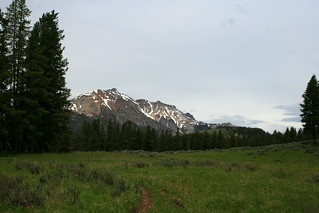 1G4. This site is close to the Gardiner River water source. This site is very open with a big fire circle that is great for a group. The campfire has very good views across the meadow and into the lower portions of the Gallatins. Even though this site is visible from the trail, I’d choose this one over 1G3 if I were backpacking by myself.
1G4. This site is close to the Gardiner River water source. This site is very open with a big fire circle that is great for a group. The campfire has very good views across the meadow and into the lower portions of the Gallatins. Even though this site is visible from the trail, I’d choose this one over 1G3 if I were backpacking by myself.
1G3. This is a more closed-in site. It is much more private than 1G4, located some distance off the trail. It does not have any real view from the cooking area or tent sites. It’s about a hundred yards to the river water source.
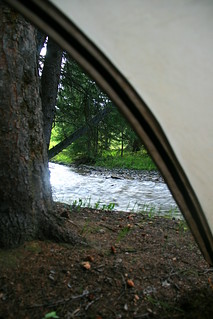 1G2. This site is also on the Gardiner River, but it’s on a different trail than 1G3 and 1G4. You can’t accommodate 16 people here. Schneider gives this site five stars, but I can’t figure out why. He likes it as a private site with a good view, tent sites, and water source. I certainly agree on the tent sites and water source, but there were no real views from the site. You can get some good views if you walk upslope a bit from the sites (no trail), but hte sites are in the woods by the river.
1G2. This site is also on the Gardiner River, but it’s on a different trail than 1G3 and 1G4. You can’t accommodate 16 people here. Schneider gives this site five stars, but I can’t figure out why. He likes it as a private site with a good view, tent sites, and water source. I certainly agree on the tent sites and water source, but there were no real views from the site. You can get some good views if you walk upslope a bit from the sites (no trail), but hte sites are in the woods by the river.
The nearby site 1G5 is for stock groups only, but it better fits Schneider’s review. It’s possible that he mixed up the two sites in his notes. For views similar to mine, see http://www.trailguidesyellowstone.com/yellowstone_hikes/fawn_pass_trail_east_yellowstone.php
Grebe Lake
There are three sites on the north side of Grebe Lake that would work well for groups. We used 4G3 and 4G4, but 4G5 would also pair well with 4G4. 4G3 and 4G4 are a little farther apart than I’d like for a group, and the trail between them is indistinct. The lake was very buggy in late June, and the area mostly seems to attract anglers. All three sites had clear views of 4G2 on the other side of the lake, which was also occupied. This reduces the privacy.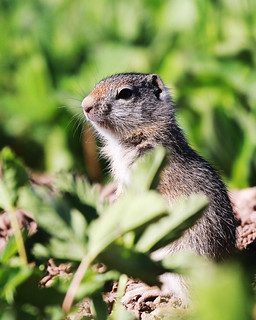
4G3 parallels the trail. It has beautiful views of the lake but is not at all private. The tent site, bear pole, and eating area are spread out in a line and more separate from one another than is true at most Yellowstone backcountry sites. There’s a community of Uinta ground squirrels between the campsite and the lake.
4G4 is a real winner, though the bear pole, eating area, and tent sites are closer together than they should be. The site is hidden in the woods but looks out over the lake.
Snake River
8C1. I love the views from this site, which go up and down the Snake River Valley. The bear pole, eating area, and tent sites line up parallel to the trail, reasonably spaced out but nowhere near the official recommendations. Because we don’t make campfires, we ate away from camp on bluffs overlooking the river. You don’t have any privacy, and the trail attracts a fair number of horsepacking groups on their way to sites on the national forest.
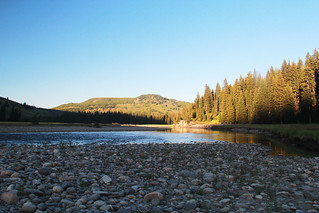 There are other sites within a reasonable distance that would make this work for a group. They’re a little farther apart than I’d like, though.
There are other sites within a reasonable distance that would make this work for a group. They’re a little farther apart than I’d like, though.
Thermal features flow into the Snake River in this area, creating one legal (and safe) soaking area next to the river. You should be aware of the risk of the Naegleri fowleri parasite, which is deadly.
Basin Creek
8B1. This site has been moved since Schneider wrote his book, and the nearby trail junction has been restructured a bit so that the site is south of the junction and not north as the maps show. Signage was not yet adequate when we were there.
Schneider calls it “semiprivate,” but it’s now a very private site. Because it’s new, it lacks a defined spur trail. If you’re coming from Snake River, look for the sign and walk uphill across the meadow. You’ll find the site in the woods. If you’re coming up the Basin Creek Cutoff Trail, turn left at the junction with Heart Lake, not right. (The NPS failed to tell us this; you might ask for details at the backcountry office.)
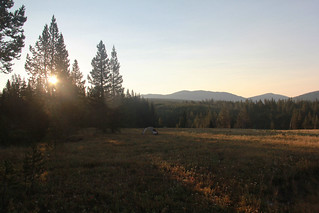
Inexplicably, the cooking area, bear pole, and best tent site are all on top of one another, so don’t use that tent site. It’s hard to find level sites in the woods, so we just found a hard site in the meadow. The meadow has quite a few bison wallows, and I wouldn’t use those! As campers have explored the site since we visited, you might find some tent pads at the edge of the woods looking over the meadow There are great views toward Overlook Mountain from that meadow, so enjoy.
Heart Lake
There are five campsites on the west side of Heart Lake. 8H2 and 8H3 share a new spur trail, but are otherwise private. We could see 8H2 from our bear pole, but the campers there never showed any awareness of us. Both sites are on the lake and allow campfires. 8H2 has a composting pit toilet with no walls. It’s visible from the cooking area, which is another example of poor landscape design by the NPS. However, we never had any problems with smells.
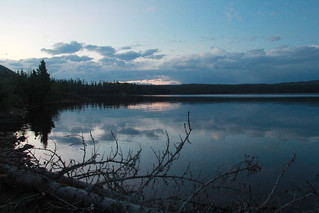
We only found one good tent site at 8H3. It has a good view of Mount Sheridan, but not of Heart Lake. However, there is a shoreline area along the lake where we watched sunrises, sunsets, and beavers.
All of the Heart Lake sites are great basecamps for a hike up Mount Sheridan. That’s a nine-mile round trip from 8H2 and 8H3, a little less from 8H4-8H5-8H6, and at least a mile more from 8H1.
Thorofare and Southeast Arm
 Park Point offers a group of three sites and a trailside pit toilet. Two of those sites, Park Point North (5E8) and Park Point South (5E9), have beautiful locations along the lake. Their meadows are also mosquito-breeding facilities, a feature you’ll notice if there is no lake off the breeze. The third site (5E7) is back from the lake, in a marshy area that has a ferocious mosquito population and no views. Avoid that one.
Park Point offers a group of three sites and a trailside pit toilet. Two of those sites, Park Point North (5E8) and Park Point South (5E9), have beautiful locations along the lake. Their meadows are also mosquito-breeding facilities, a feature you’ll notice if there is no lake off the breeze. The third site (5E7) is back from the lake, in a marshy area that has a ferocious mosquito population and no views. Avoid that one.
Three miles further south you’ll find Columbine Meadow (5E6), a lovely spot where I have had lunch but never stayed. This is nine miles from the trailhead, so it gives you the mileage you need for your first (or last) day on the trail to the Thorofare Ranger Station.
5E4 Brimstone Bay is a lovely lakeside side with a beautiful view of Yellowstone Lake and Promontory Point, down an easy 0.2 mile spur from the trail. It rightly earns five stars from Schneider. My only concern in August 2017 was that there were a lot of snags in and around the campsite – one fell down during our dinner on a perfectly calm day. While the park had cleaned up those by July 2022, my students found new widowmakers. Place your tent well.
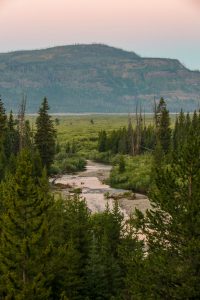 The Beaverdam Creek area has two campsites some distance apart, and my old map shows that both of them have been moved. Beaverdam Creek 5E1 is west of the trail, on a spur that will take you a few hundred yards away from the junction – and your water source at the Beaverdam Creek ford. The tent sites are squeezed into a narrow space between a steep slope and the forest, but the views are fantastic. It’s a long way to water, though.
The Beaverdam Creek area has two campsites some distance apart, and my old map shows that both of them have been moved. Beaverdam Creek 5E1 is west of the trail, on a spur that will take you a few hundred yards away from the junction – and your water source at the Beaverdam Creek ford. The tent sites are squeezed into a narrow space between a steep slope and the forest, but the views are fantastic. It’s a long way to water, though.
6B4 Beaverdam Meadow seems to have new routing when we were there in 2017, with about half the 0.4 mile spur trail essentially guesswork through a meadow. That meadow seems popular with horse parties, and we saw a lot of, uh, horse sign there in 2017. Horse sign was much less in 2022 and 2023. The food area and tent sites don’t have views. It’s a short walk to the creek, with constricted views of the mountains but lots of privacy. This site is the approximate location of one of the 1870 Washburn-Langford-Doane Expedition’s campsites, and still gives a group lots of room.
6C2 River’s Edge is a beautiful site on a bluff above the Yellowstone River with a number of good tent sites. When the river is high (as in 2017), it was challenging to get down the bluff to water. Unless you’re on horse, the mile-long spur trail entails some route finding to cross streams in the meadow and to reach the well-marked campsite.
 6D3 surprised me. It’s on a small triangle of land between braids of Mountain Creek, barely hiding out of view from the trail. If other hikers or, say, a bull bison are using the ford, you’ll see them if you step ten feet from the cooking area. The sunset views were glorious to both the west and the east, as the warm light hit the Absarokas. Schneider only gives it three stars because it’s not exactly private, though traffic is so light on the Thorofare Trail that I don’t think that’s a problem. I’d give it five stars for space, “swimming” hole, and views. The only downside is that, no matter which way you’re traveling, you start your morning with a ford. Brrr!
6D3 surprised me. It’s on a small triangle of land between braids of Mountain Creek, barely hiding out of view from the trail. If other hikers or, say, a bull bison are using the ford, you’ll see them if you step ten feet from the cooking area. The sunset views were glorious to both the west and the east, as the warm light hit the Absarokas. Schneider only gives it three stars because it’s not exactly private, though traffic is so light on the Thorofare Trail that I don’t think that’s a problem. I’d give it five stars for space, “swimming” hole, and views. The only downside is that, no matter which way you’re traveling, you start your morning with a ford. Brrr!
6Y6 Three Mile Bend on the Yellowstone River has a beautiful view and a lot of mosquitoes. This was the only place we used our head net in 2017. Most of the group used head nets in 2022, though I didn’t. The mosquitoes were better behaved in 2023, and don’t remember anyone using the head nets both nights. It’s easier to get down the bluff for water than it is at 6C2, but there was no flat space at the river’s edge in 2017 – we were balancing on slick mud. In 2022 and 2023, water levels were lower and we had a nice beach downstream from the camp. The spur trail required some bushwhacking through the willow, but the route finding is easy if you stay close to the river. (Horse parties will want to stay away from the river and look for a gap in the woods to the left once the river is no longer visible.) There was a lot of bear sign there in 2017, and we met someone who had a grizz examine her bag at the food pole two days before. We heard wolves both nights in 2022 and 2023, with fresh wolf and elk prints the first morning.
6Y5 Cliff Creek. I have not been to the actual campsite, but it clearly lies inside a stand of trees downhill from the trail and at the edge of a wetland. Some parts of the site are visible from the trail. Looking up, Cliff Creek descends between two arms of The Trident, and supposedly you can scramble to the falls. I had reserved this site in 2022 but the bear pole was damaged in the June storms so the NPS rerouted us. Next time.
Shoshone Lake
 8S0 and 8S1 are two campsites next to each other, both next to the Shoshone Lake Ranger Cabin. The paddler site is just back from the lake, with the lovely beach you see here. I had lunch here before exploring the eastern shore. The backpacker site is back from the lake and right next to the trail, with a terrible pit toilet. The two sites seem to have been classified as one in Schneider’s book, and he gives the paddler site four stars.
8S0 and 8S1 are two campsites next to each other, both next to the Shoshone Lake Ranger Cabin. The paddler site is just back from the lake, with the lovely beach you see here. I had lunch here before exploring the eastern shore. The backpacker site is back from the lake and right next to the trail, with a terrible pit toilet. The two sites seem to have been classified as one in Schneider’s book, and he gives the paddler site four stars.
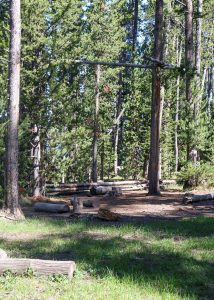 8S1. The backpacker’s site is further inland, near the trail junctions. The backpackers’ site has peek-a-boo views of the lake. It’s an easy walk down to the beach, offering great views of beautiful Shoshone Lake. As you can see in the photo, the backpackers’ site is serviceable but unexceptional. The outhouse has reached that stage (in 2022) where screws and nails no longer hold everything together, so gravity makes those decisions.
8S1. The backpacker’s site is further inland, near the trail junctions. The backpackers’ site has peek-a-boo views of the lake. It’s an easy walk down to the beach, offering great views of beautiful Shoshone Lake. As you can see in the photo, the backpackers’ site is serviceable but unexceptional. The outhouse has reached that stage (in 2022) where screws and nails no longer hold everything together, so gravity makes those decisions.
8S2. I didn’t stay here but walked through the middle of it, and talked to someone staying there. There’s a tent spot about 10-15 yards of the trail but the cooking area is right on the tail, with the lake on the other side of the trail. Pretty but not private.
8S3. This was empty when I walked through it, but is similar to 8S3 with perhaps a little more privacy.
8R5. This is a gorgeous site well off the trail. The bear pole and cooking area are on a small bluff above the lake. You could also bring your food down to the shoreline for views of the Shoshone Geyser Basin and Shoshone Lake. The site lies down a good spur trail, about a half-mile from the trail. There’s a pit toilet (no walls) and abundant tent sites, all an appropriate distance from the cooking area and each other. The shoreline offers great sunrise and sunset views in September. The site is very private unless you’re on the shoreline and a canoe goes by on the way the geyser basin.

